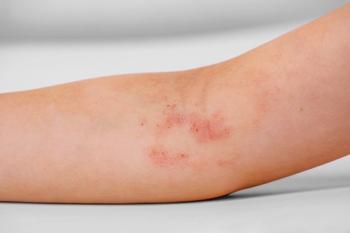
- Consultant for Pediatricians Vol 9 No 1
- Volume 9
- Issue 1
Acanthosis Nigricans
A 5-ft 1-in, 183-lb 14-year-old girl was concerned about the areas of thickened hyperpigmentation on her posterior neck and in her cleavage.
A 5-ft 1-in, 183-lb 14-year-old girl was concerned about the areas of thickened hyperpigmentation on her posterior neck and in her cleavage.
The lesions had a velvety appearance and were asymptomatic. She was not taking any medications. In the past, she had been told to apply a combination of lactic acid and urea to the areas; this treatment resulted in a softening of the affected skin but did not reduce the hyperpigmentation.
Yearly measurements of blood glucose and insulin had been normal. These findings were consistent with a benign acanthosis nigricans.
Acanthosis nigricans, a nonspecific increase in the thickness of the prickle cell layer of the skin, is most commonly associated with obesity. It is also known to develop in persons with diabetes, corticosteroid excess, pineal tumors, endocrine disorders, and genetic variants; nicotinic acid and estrogen may also induce these pigmentary changes. The hyperpigmentation typically involves the axillae; however, it may arise in flexural areas of the neck and groin, the belt line, dorsum of the finger, around the umbilicus and the areola of the breast, and in the mouth.
Most cases of benign acanthosis nigricans are caused by heat and friction in the flexural folds. Losing weight can help reduce skin friction and promote spontaneous resolution of the hyperpigmentation. This patient was advised to lose weight with diet and exercise.
Articles in this issue
over 15 years ago
Acute Lymphoblastic Leukemia Presenting as Soft Tissue Massalmost 16 years ago
Infant With Persistent Noisy Breathingalmost 16 years ago
Asymptomatic Girl Who Passes Threadlike Object in Stoolalmost 16 years ago
Melatonin Use in Children With Neurodevelopmental Disordersalmost 16 years ago
Two girls present with toenail yellowing and thickeningalmost 16 years ago
Children With Head Trauma: To CT or Not to CT?almost 16 years ago
What Is This Axillary Lump?almost 16 years ago
ParaphimosisNewsletter
Access practical, evidence-based guidance to support better care for our youngest patients. Join our email list for the latest clinical updates.














